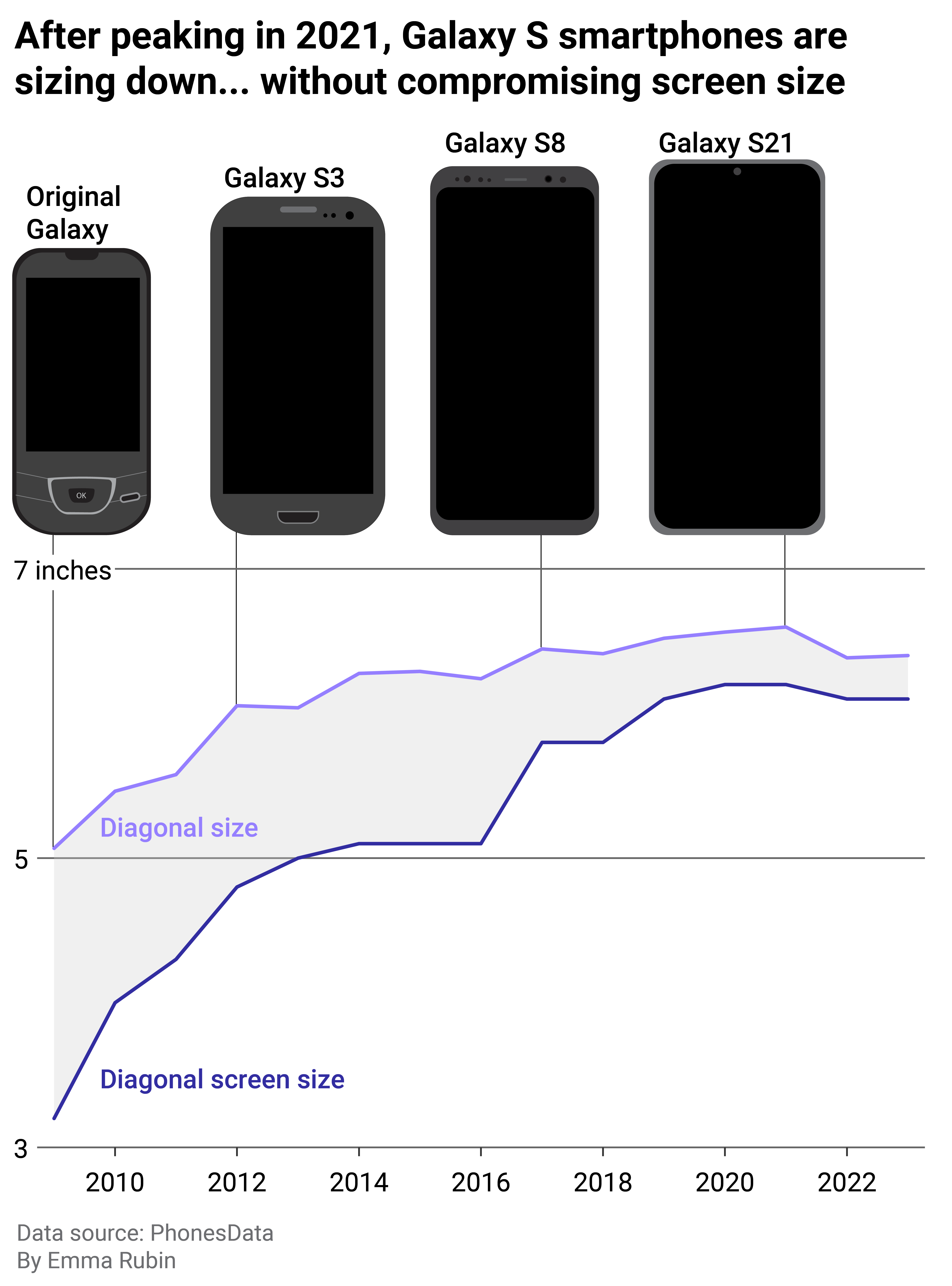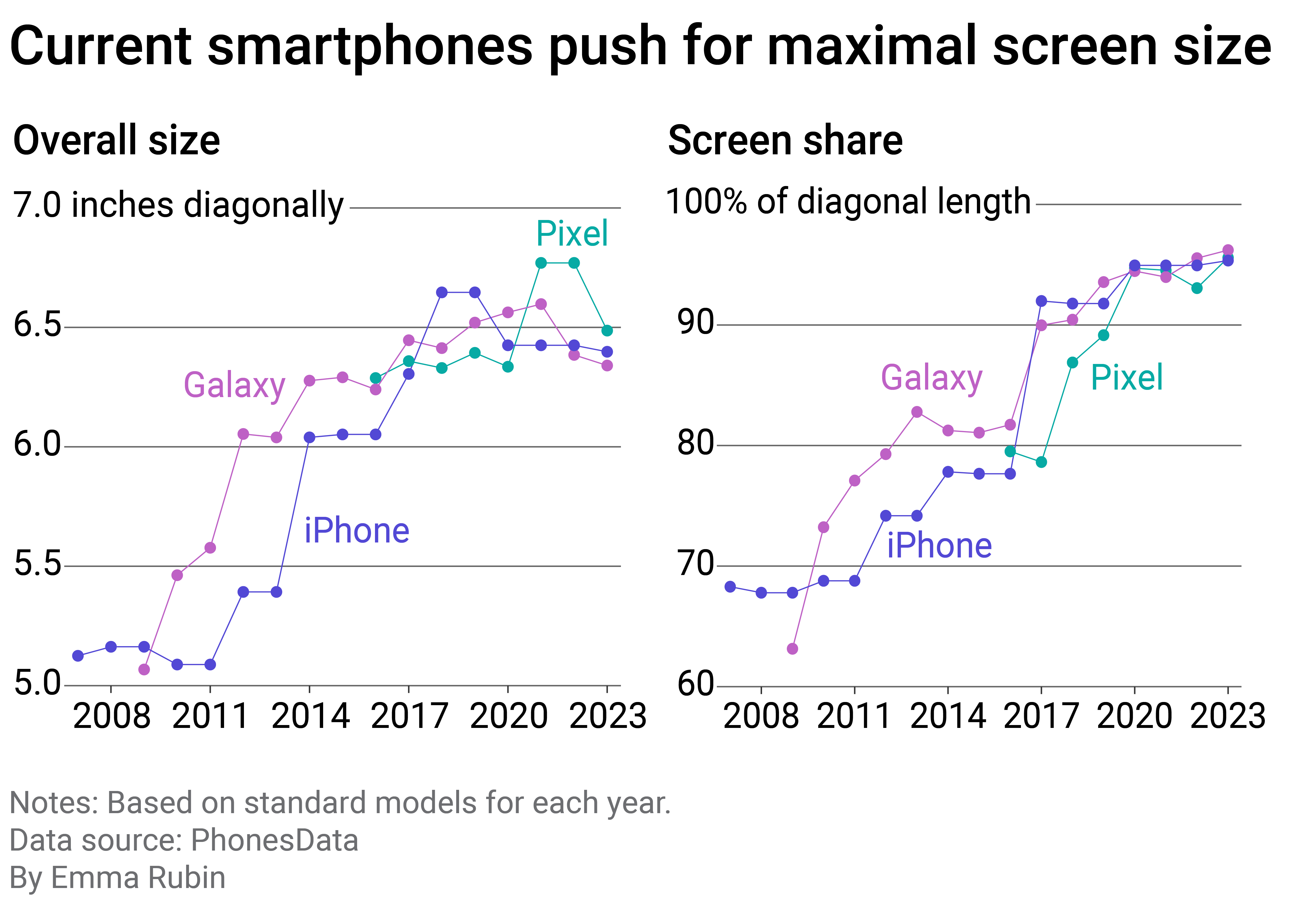Cell Phone Size Comparison
When it comes to cell phone size comparison, oftentimes it’s the screen dimensions that make the biggest difference, not the size of the phone itself. However, times really have changed with regards to smartphones and how big they are.
For example, on the left, below, is me updating a new iPhone 6s from an iPhone 4. Then, on the right, is me updating that iPhone 6s to an iPhone 13 earlier this year. The size difference is remarkable.
I mean, the iPhone 6s looks so much bigger than the iPhone I had before. And then the iPhone 13 looks so much bigger than the 6s. Can you imagine if I still had the 4s (I sold it on Gazelle for cash) and put it next to the 13? Wowza!
In that time, we’ve gone through a bunch of Otterbox phone cases. Thank goodness for the Otterbox phone case warranty.

Smartphones used to be half the size they are today
Pacing back and forth on an auditorium stage in his signature black turtleneck and blue jeans, Steve Jobs addressed members of the media one mid-July morning in 2010.
Apple’s chief executive was responding to reports that consumers were having their phone calls dropped when using the latest device, the iPhone 4. The company had found a way to incorporate the cellular antenna into the stainless steel frame of the phone, saving precious real estate. But some wanted to know: Why not just make the phone slightly bigger, as its rivals had?
“No one’s going to buy that,” Jobs replied.
The tech oracle credited with bringing smartphone technology into the 21st century had strong opinions. Chief among them was a belief that the American consumer did not actually want a phone so large it couldn’t fit in the palms of their hands. Gee, Steve, you should have looked to the failed Palm Pilot to know the answer to that question.
Jobs was focused on building the best cellphone on the market at a time when other manufacturers were focused on adding cameras, games, and other functionality he felt detracted from the devices.
Save this article and we’ll send it to your inbox. Plus, we’ll send you more great links each week.
Was Jobs wrong? This year’s slate of updates to smartphone lines from Google, Apple, and Samsung and the consumer demand for them in recent years may suggest so.
One thing is growing more certain with each model year introduced to the public—smartphones aren’t getting much smaller. Especially now that Apple has officially dropped the iPhone Mini. It was one of the last small-sized smartphones with high-end internals.
Phone size growth
Here’s a look at how cell phone sizes have changed:
- Today’s flagship Apple smartphone, the iPhone 15, covers a 51% larger surface area; it is 27% heavier than the original iPhone.
- Samsung’s flagship Galaxy smartphone area has grown 60% larger, its weight 45% heavier.
- Google’s flagship Pixel line has put on a solid 44 grams, making it 31% heavier than the original Pixel. Now, it features a 7% larger screen than when it debuted.
Stacker compiled smartphone specs from PhonesData for the bestselling device makers in the U.S. to illustrate how our phones have grown ever larger over the last two decades.
Emma Rubin // Stacker
Samsung’s Galaxy line of phones sees most dramatic upsizing
Samsung’s flagship Galaxy series launched in 2010. It leaned into larger phone sizes that accommodated better hardware. They did this, even if it meant pushing the phone size a little wider, taller or thicker. This was long before Apple was comfortable doing the same. The initial few Galaxy S series phones featured more robust specs on paper, making Apple’s popular operating system and thriving third-party app store some of the company’s biggest differentiators 10 years ago.
Emma Rubin // Stacker
Android handsets push hardware
Initially, Samsung’s larger-sized phones helped accommodate more advanced camera technology, larger screens, and screaming-fast processors. It ran a proprietary version of the open-source Android software acquired by Google in the mid-aughts. Samsung’s willingness to push the boundaries of ergonomics and think of the phone as a general-purpose entertainment device served it well in terms of sales.
iPhone soon follows suit
In the subsequent years, Apple followed Samsung’s lead, increasing the size of the touch screens it made available to customers. The devices the company’s founder once annoyingly described as the “Hummers” of smartphones, in hindsight, are now its true north.
One of the biggest changes on these larger iPhones? No home screen button. I know it took me a long time to get used to “flicking” the screen to wake it up or go back to my home screen versus pressing the home button like I did with earlier versions.

Google Smartphones change, too
Google itself had released a few smartphones of its own as the smartphone competition heated up. Ultimately, though, the company struggled to compete in the early 2010s. It experimented with a phone dubbed the Google Nexus, which was manufactured by HTC and lacked multi-touch controls. The Nexus line was discontinued in 2016.
Emma Rubin // Stacker
Apple’s waning interest in small phones
First revealed to the public in September 2014, the Apple iPhone 6 became the handset manufacturer’s biggest departure from Jobs’ ethos of ergonomic smartphones. I didn’t upgrade to the iPhone 6 from my iPhone 4 until 2015.
Even still, the iPhone 6 is also the company’s best-selling phone of all time. Where the iPhone 5 was sold as a phone your thumb could reach every corner of, the iPhone 6 was the first in the iPhone lineage to split models into a standard and plus size.
In the aftermath of Apple’s latest device reveal in September, observers quickly pointed out the lack of a smaller version of its smartphones. Apple dropped the “mini” from its lineup in 2022 and didn’t bring it back this year. The company’s budget model that doesn’t typically include the latest and greatest hardware, the iPhone SE, is rumored to get a refresh in the next year or two. For now, it may be consumers’ only compact option.
However, how long it will last in the lineup is anyone’s guess. Bloomberg has previously reported that Apple’s more expensive, high-end flagship model, the iPhone 14 Pro, saw more demand than the entry-price iPhone SE.
And now celebrity spokespeople like Justin Bateman and Sean Hayes are hawking the iPhone 15 Pro with titanium for Verizon. I’ll admit it — those commercials tempted me to upgrade, even though my phone is only one year old.
Emma Rubin // Stacker
Have we hit the sweet spot?
While phone screens have grown, their operators’ hands have not. And the reach of one’s thumb generally dictates whether a phone screen will serve them well, experts have found. Bigger is not always better.
But at least one study funded in part by the National Science Foundation suggests even the size of the 3-inch iPhone 3G was never all that ergonomic unless used with both hands.
Google’s latest flagship phone, the Pixel 8, now stands over its competitors. You can buy an unlocked Pixel 8 at Target.
At the same time, Samsung and iPhone have slowed the expansion of their flagship phone sizes. Instead, each has begun issuing separate larger model sizes, with Apple branding its plus-sized line the “Pro Max” line.
Samsung offered the large Galaxy Note series, ultimately rebranded as the “Ultra” version of its Galaxy S line, now in its 14th edition. Samsung was also the first major handset maker in the U.S. to venture into the nascent foldable smartphone market.
Google has now released its own folding-style phone, dubbed the Pixel Fold.
The new devices attempt to split the difference by allowing consumers to transform the tablet-sized screen into something half as wide and twice as thick. However, demand for the modern twist on the classic flip phone has been hard to gauge.
Despite statements from Samsung characterizing sales growth as positive for its foldable phones, some analysts point to high prices as a consumer barrier. Meanwhile, the global market for foldable phones has grown over the last year, while the overall smartphone market has shrunk.
Bags that fit larger cell phone dimensions
Years ago, I treated myself to a Coach wristlet that was perfectly sized for my iPhone4. I took that purple wristlet everywhere. It was perfectly sized for the phone, a credit card and some cash.
I’m sure you can imagine what happened when I bought the iPhone 6s. It was too small to fit my new phone. So, I upgraded to a Marc Jacobs mini crossbody Snapshot bag in purple. I treated myself to it during the Nordstrom Anniversary Sale. Thankfully, that bag fits my iPhone 13, too.
Another bag that definitely fits my iPhone 13 is the lululemon crossbody belt bag. I bought it at the Peloton store near me.

Data reporting by Dom DiFurio and Emma Rubin. Story editing by Jeff Inglis. Copy editing by Paris Close. Photo selection by Elizabeth Ciano.



